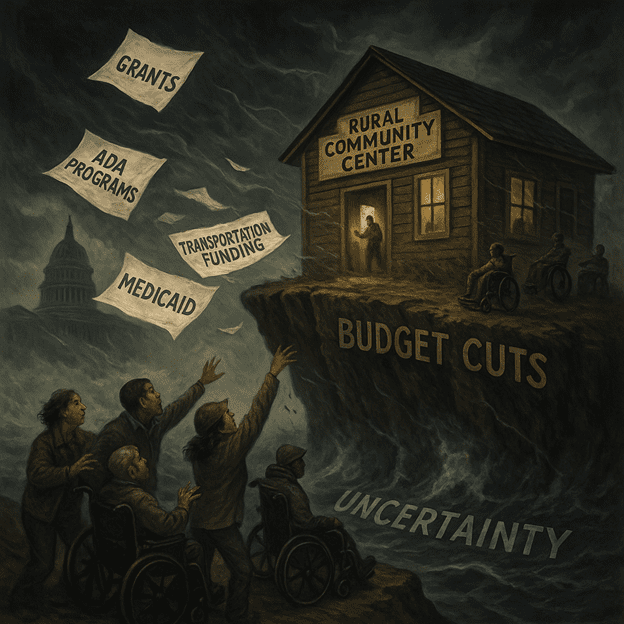
We are rapidly approaching the final quarter of LIFTT’s fiscal year; time is sprinting toward October 1, 2025, the start of FY 2026. Let me ask you: Are we going to have a financial runway? Are we going to remain open? Will we continue serving South Central and Eastern Montana like we have pledged? Can we actually finish the ADA‑Accessible Rural Transportation Program? Further, what about all the other agendas we kicked off this year?
The simple truth: No, because the grants and funding streams that keep LIFTT (and every American Center for Independent Living) alive are shrouded in deep uncertainty.
Here is what we know:
- The Executive branch has unleashed its FY 2026 “skinny budget” — a sweeping package that would slash domestic, non-defense spending by $163 billion, disassembling agencies such as USAID, EPA, NIH, CDC, HUD, and dismantling critical social-safety-net programs.
- The Administration for Community Living (ACL), the hub that funds programs like Aging & Disability Resource Centers, Protection & Advocacy, and Independent Living, has been singled out. The proposal would abolish ACL, dispersing its duties into a newly created Administration for Children, Families & Communities. Key programs such as Protection & Advocacy, UCEDDs, and voting access could vanish. Even though the FY 2026 budget justification calls for level funding of CIL grants (Part C) and an increase to Part B State Grants. That funding comes saddled with a caveat: money could be reallocated to fill the gap from eliminated programs.
- On Capitol Hill, the US House budget reconciliation bill (passed May 22) includes Medicaid cuts of $715 billion over 10 years, risking the loss of healthcare coverage for 13.7 million Americans, obviously including many people with disabilities and rural residents.
- States and advocacy groups are sounding alarm bells. The Disability Rights Center of Kansas reports that protection and advocacy grants plummeted from $45 million (FY 2025) to zero in FY 2026. The Center for Nonprofit Excellence warns of sweeping cuts for housing, environmental agendas, public health, and substance abuse programs by up to 22.6%.
- National organizations, such as the National Council on Independent Living (NCIL), the Associated Programs for Rural Independent Living (APRIL), and the National Association of State Independent Living Councils (NASILC), are united in their response. While recognizing that the leaked OMB memo preserves CIL funding for now, they emphasize that several disability programs are threatened as ACL is dismantled. These organizations are urging lawmakers to uphold funding and resist infrastructural upheaval.
So… what does this mean for LIFTT?
- Grant monies for FY 2026? Still unknown. The White House has dropped a preliminary blueprint that could eliminate urban disability supports, voting access, transportation programs, and state councils without prior warning.
- Our ADA Rural Transportation Program? On shaky ground. If FTA and/or ACL program grants are trimmed or delayed, our wheels will not move forward.
- Staffing and services? The House bill’s Medicaid/SNAP reductions risk stretching Montana’s rural hospitals and physical access supports to their breaking points. Our referral partners will be forced to scale back, which will impact LIFTT’s ripple effect.
Let us not despair
Yes, the President’s “skinny budget” is only a wish list. Congress has the final say. We anticipate that there will be pushback: GOP appropriators are already distancing themselves from the cuts. In fact, thanks to advocacy, some aging & disability programs earlier slated for funding elimination have been saved (but have been flat-funded, which still equates to cuts when inflation is factored in).
Still, the entire process hinges on timing:
- The White House budget debuts in Spring 2025 (April–May)
- Congressional appropriations and/or reconciliation debates commence in Summer–Fall 2025
- Final FY 2026 budget adjustments must be done by September 30
That leaves us with a window from now until late September in a tight deficit limbo.
What you can do:
- Write letters, make calls, and alert Congress, particularly our Montana delegation of Senator Daines, Senator Sheehy, Representative Downing, and Representative Zinke, not to zero out ACL, not to slash Medicaid or SNAP, and to protect CIL funding for the rural population of Montana.
- Partner with LIFTT, the Montana CILs, NCIL, APRIL, and NASILC to keep your voice heard.
- Prepare for contingencies, including program delays, ramped-up fundraising efforts, and volunteer shortages. Let’s draw up our upside blueprint now in the event of grant checks getting delayed or canceled.
The last quarter is here: Our future is murky. LIFTT’s fight is now.
We have passed the “hope” and “inspiration” phase. The grants that seed our programs are under ideological siege. If Congress folds, LIFTT will lose core funding, which will threaten service continuity. We can advocate, prepare, and communicate with staff, board, and community alike. When October 1 arrives, despite the outcome, LIFTT should be ready to adapt, pivot, and push forward, because “independent living” doesn’t end with budget cuts — it begins.

About Living Independently for Today & Tomorrow (LIFTT): LIFTT is a Montana 501(c)3 corporation organized as a Center for Independent Living (CIL). With team members based in Billings and Glendive, LIFTT provides aging and disabled members of the community with programs and services that help empower them to break down the physical, bureaucratic, and cultural barriers that prevent them from being fully independent participants in their lives and communities throughout 18 counties in southeastern and south-central Montana: Big Horn, Carbon, Carter, Custer, Dawson, Fallon, Garfield, Golden Valley, McCone, Musselshell, Powder River, Prairie, Richland, Rosebud, Stillwater, Treasure, Wibaux, and Yellowstone. For more information, please visit liftt.org or download our mobile app for your Apple or Android Device.
